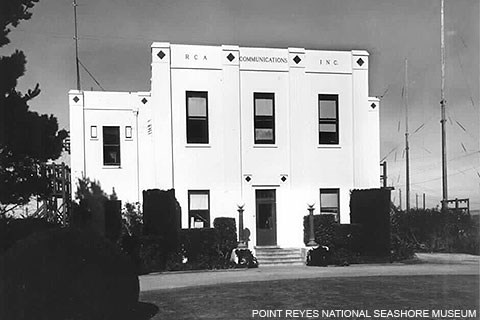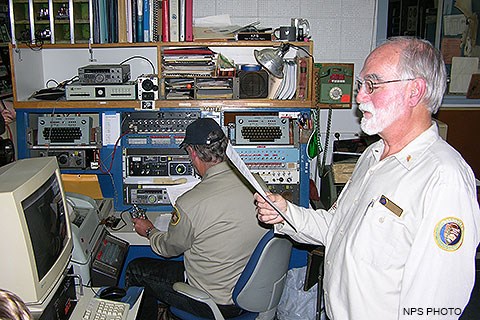
The early 1900s was an exciting time of innovations in communications. Wireless transmission and ship to shore communication were rapidly growing enterprises. In 1901, Gugliemo Marconi, an Italian inventor and electrical engineer, heard the first tap of his wireless telegraph system—the letter "S" in Morse code across the Atlantic Ocean. In 1912, the wreck of RMS Titanic highlighted how wireless telegraph systems could safeguard lives and property at sea. Wireless operators could tap out messages at about fifteen words per minute, calling other ships and shore stations for aid more quickly than earlier technology allowed.
In 1914, the Marconi Wireless Telegraph Company of America (aka American Marconi) built and operated an overseas wireless telegraphy transmitting station in Bolinas and a receiving station on Tomales Bay in Marshall to better communicate across the Pacific. The two stations were once in the forefront of communication technology and formed the foundation for the one of the most successful and powerful ship-to-shore wireless stations on the Pacific Rim. From the Point Reyes area, operators tapped out Morse code messages which were heard across the Pacific Ocean.
The Radio Corporation of America (RCA) acquired American Marconi in 1920 and, by 1929, was seeking to purchase the G ranch on the Point Reyes peninsula because of its proximity to the ocean for a third station to receive signals transmitted from across the north Pacific. After acquiring the property, RCA built an Art Deco-style receiving station between 1929 and 1931, which supplanted the Marshall station. Saplings of Monterey cypress, one of the few tree species adaptable to wind and ocean weather conditions, were planted lining the station’s access road.
During World War II, RCA Ranch (aka G Ranch) was used by military and Coast Guard personnel who were stationed on the ranch to patrol nearby beaches.
At some time during the past few decades, an urban legend began circulating among many in West Marin that the RCA facility on the Point Reyes peninsula was the first radio station on the mainland USA to receive news of the attacks on Pearl Harbor on December 7, 1941. However, there are no records from the station that it received direct word from Hawai'i on that day, although the stations in the Point Reyes area did help relay the news to ships across the north Pacific.
World War II spurred even more developments in communications, such as LORAN (long range aid to navigation) and GPS (global positioning systems), which ultimately replaced the need for Morse code operators and ocean-front technical stations.
The receiving station on the Point Reyes Peninsula has used the KPH call sign since 1946. The original PH call sign, from which KPH was derived, was first used when a radio station was established in the Palace Hotel (PH) in San Francisco.
Saving a Piece of History
The National Park Service acquired the property 1999 and, in 2000, established a partnership with the Maritime Radio Historical Society (MRHS) to protect and maintain facility and the equipment. Park staff and dedicated volunteers work to preserve the structures, artifacts, and records of the historic RCA/Marconi radio facilities, including the Bolinas transmitting station and the Point Reyes receiving station. Few of the succeeding generations of antennas—arranged in "farms,"—remained at the two sites. However, the radio equipment, ship-to-shore Morse communications, and teletype—some of it dating to the World War II-era—remains intact, has been restored and made functional, and is used to broadcast on numerous frequencies, including KPH. The Monterey cypress "tree tunnel" at the Point Reyes station is a signature landscape feature that evokes some of the prestige that RCA placed in this profitable operation.
The facilities date from 1914, the earliest days of wireless communication, and research indicates that these sites—together with the Marshall Marconi receiving station (now a California State Park conference center)—comprise what appears to be the last intact Marconi-era coast station in North America. Studies are underway to ultimately list both National Seashore sites and the Marshall facility as a multiple property National Historic Landmark.
In 2000, the park archivist began the task of organizing over 200 linear feet of operations records inherited from MCI (which acquired the RCA Global Communications division in the 1980s) and coordinated curatorial work related to preserving the historic radio equipment. Volunteers from the Maritime Radio Historical Society (MRHS) logged have logged thousands of hours organizing and restoring artifacts and equipment. MRHS volunteers also put station KPH back on the air on July 12, 2000, for the first of many annual July 12 commemorations of the last commercial transmission of Morse Code in the U.S.
Visiting the Historic KPH Maritime Radio Receiving Station
Volunteers from the Maritime Radio Historical Society staff the Historic KPH Receiving Station on most Saturdays from noon to 5 pm and are happy to give visitors who drop by brief or extended tours to match visitors' time and interest. Follow Sir Francis Drake Boulevard west towards the Lighthouse until you see the sign for the North District Operations Center. Turn right and pass through the "tree tunnel" to get to the Receiving Station. Park in the lot on the left before the turn-around. Please visit our Historic KPH Maritime Radio Receiving Station and Cypress Tree Tunnel page for more information.

Night of Nights
Night of Nights is an annual event held on the 12th of July by the MRHS to commemorate the history of maritime radio and the closing of commercial Morse operations in the USA. These on-the-air events are intended to honor the men and women who followed the radiotelegraph trade on ships and at coast stations around the world and made it one of honor and skill.
KPH, the ex-RCA coast station located within Point Reyes National Seashore, returns to the air for commemorative broadcasts on July 12 each year at 5:01 pm PDT (13 July at 0001 GMT). At 5 pm on July 12, 1999, radio operators thought they had broadcast the last commercial Morse transmission in the U.S. Transmissions usually continue until at least midnight PDT (0700GMT).
Members of the public are invited to visit the receiving station for this event. The station is usually open to visitors beginning at 3 pm PDT. See our Night of Nights page or the MRHS site for more details about this event.
|
PODCAST
- Home
- CLIP ITALIA
- CLIP NORD AMERICA
- CLIP PIRATA
- CLIP SUD AMERICA
- CLIP ASIA
- CLIP EUROPA
- CLIP AFRICA
- CLIP UTILITY
- A23 HFCC SCHEDULES
- TRASMISSIONI IN ITALIANO
- QSL CARDS
- HAM QSL
- SHACK
- RADIO STICKERS
- GREYLINE
- THE ANTENNA BOOK
- HAM CLUSTER
- TOWERS
- RADIO TALES
- GENTE DI RADIO
- RADIO MUSEUM TORINO
- RADIOCITY 2017
- VILLA GRIFFONE
- YOUTUBE
- ANTENNE GALIZIA
- RADIO MUSEUM ROMA
- RADIO TALES #2
- PODCAST
- RADIO RAI. VIA ASIAGO
- RADIO STAMPS AND FDC
- RADIORARIO DEL 1929
- WORLD RADIO DAY MILANO 2024
- MILANO DX MEETING 2025
SCORREVOLE 2
2020-05-03
KPH POINT REYES: VIDEO DOCUMENTARY AND HISTORY
Subscribe to:
Post Comments (Atom)

No comments:
Post a Comment